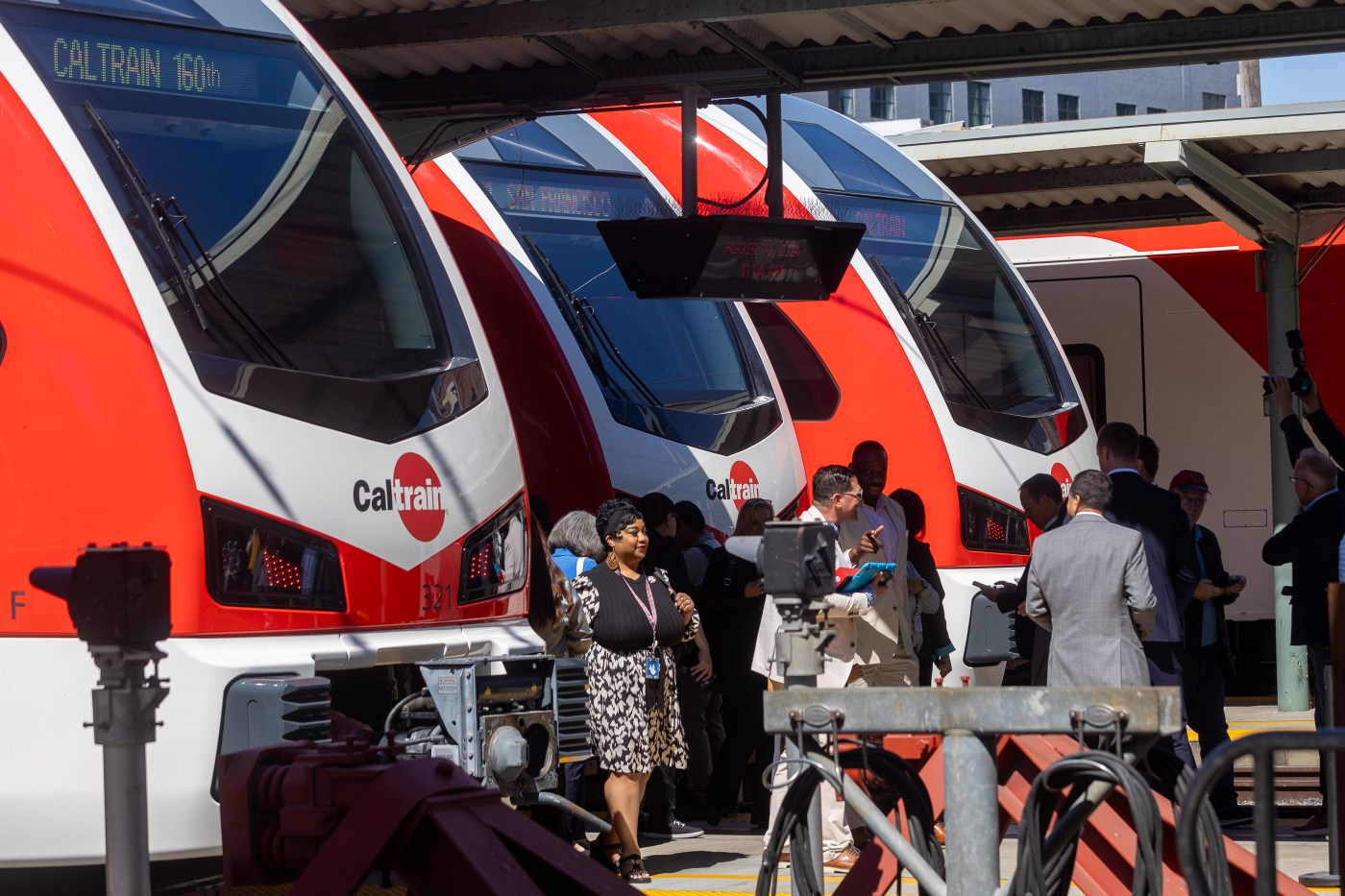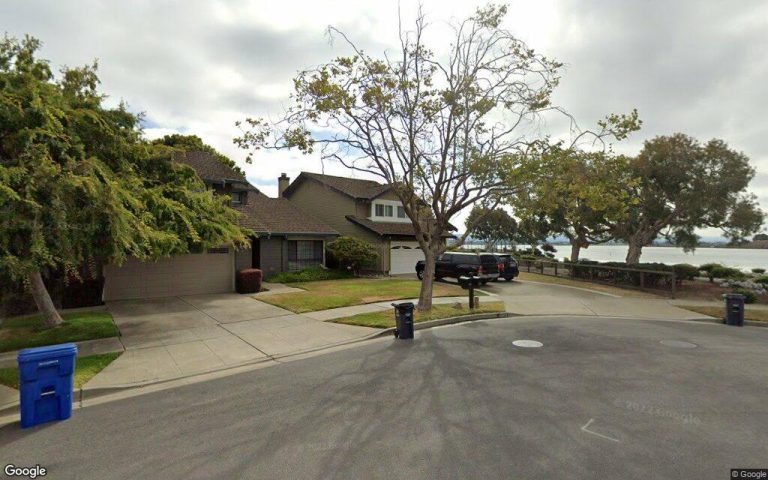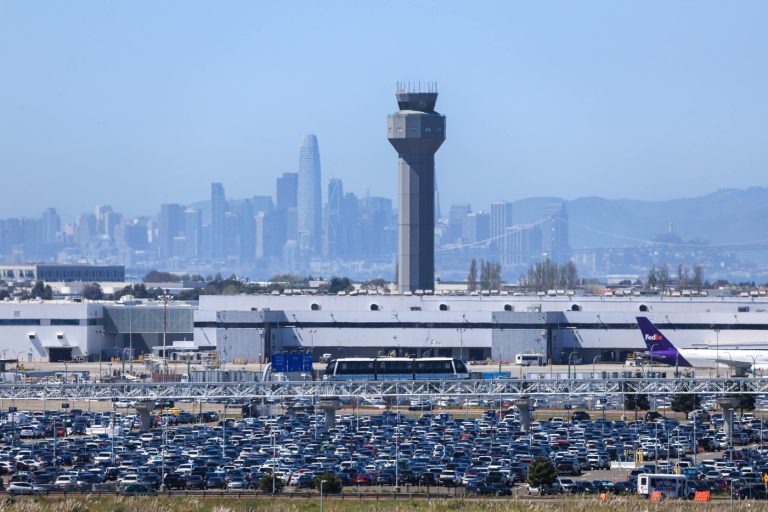Caltrain is finally electrified.
After more than seven years of construction, lawmakers, including Gov. Gavin Newsom and former House Speaker Nancy Pelosi, business leaders and transportation officials boarded an electric train on Saturday for an inaugural trip from San Francisco to Millbrae and back.
It was a short, but smooth, ride that drew applause from the several hundred people on board when the train returned safely to the San Francisco station.
“Today marks a momentous milestone for an electrified rail service that will serve our region for decades to come,” said Assemblymember Marc Berman, a Democrat representing Menlo Park. “The quieter, cleaner and faster trains will advance quality of life on the Peninsula. As we approach the light at the end of the tunnel, I congratulate Caltrain for their decades of hard work to get to today, and invite everyone who lives and works along the Peninsula to come out and see the future of Caltrain for themselves.”
Caltrain engineer Doc Smith is surrounded by photographers during the debut of Caltrain’s electrified train service, Saturday, Aug. 10, 2024, in San Francisco, Calif. Smith drove the train back from Millbrae after a ceremony roundtrip to Millbrae. (Karl Mondon/ Bay Area News Group)
On Sunday, electric trains will run their first regular service for the public. Additional electric trains will be introduced every week until the launch of the new schedule and full electrified service between San Francisco and San Jose starting Saturday, Sept. 21.
Saturday’s VIP event had a party atmosphere, loads of Caltrain swag and a roster of speakers who all — at some point — made the project possible. The event was capped off by Newsom and Pelosi yelling “All aboard!” from the conductor’s window as hundreds boarded the shiny new red and white train.
Caltrain says the $2.4 billion electrification project, which faced delays and other hurdles, signals a landmark shift toward a faster, more frequent and more environmentally friendly public transportation network along the San Francisco Peninsula.
Express service will allow commuters to travel between San Francisco and San Jose in under an hour. Previously, it took an hour and five minutes to serve seven stations. The new trains will serve 11 stations in 59 minutes.
The new trains will also increase service by 20% because they can accelerate and decelerate much faster than diesel trains. Sixteen stations will see trains every 15-20 minutes at peak hours and all stations will see service every 30 minutes on the weekend compared to previous one-hour wait times. The new trains also increase access and service to low-income and underserved communities by more than 25%, a Caltrain spokesperson said.
Caltrain says electrification will also help meet ambitious regional and state climate action goals by lowering greenhouse gas emissions, improving air quality and relieving traffic congestion. By transitioning from diesel to electric trains, carbon dioxide emissions will be cut by 250,000 metric tons annually — equivalent to removing 55,000 cars from the road each year, officials said.
“Today marks the beginning of a cleaner, greener and more connected Bay Area, led by an electrified Caltrain that will improve our air quality and combat climate change, providing real benefits to everyone who calls this region home,” said State Sen. Josh Becker, representing San Mateo County and part of Santa Clara County.
Gov. Gavin Newsom pretends to trim the hair of Senator Alex Padilla with his ceremonial ribbon scissors during a ceremony for Caltrain’s new electrified rail service, Saturday, Aug. 10, 2024, at the San Francisco terminal. (Karl Mondon/ Bay Area News Group)
The new trains will also offer enhanced amenities, including better Wi-Fi, new digital onboard displays, power outlets at each forward-facing seat, energy-efficient lighting, an improved climate control system, baby-changing tables in the bathroom, security cameras and expanded storage under the seats.
Officials said the project created 33,000 jobs in 36 states, fueling economic growth and innovation within the local communities and nationwide.
The project was a joint effort between the state, which contributed more than $1.1 billion, the federal government, which kicked in $1 billion, and local funding sources, which put $262 million toward the project, Caltrain officials said.
Caltrain is the first electric rail system in California history.
“The completed Caltrain project is an integral part of high-speed rail and the story California is telling about clean transportation,’’ Newsom said in a statement. “And Californians are already seeing the results for themselves as we electrify Caltrain, finish structures, lay track, design and build stations and buy trains. We’re making rail real in California.”
Saturday’s rollout comes 25 years after the initial idea for an electrified system was conceived.
“Since 1999, electric trains have been proposed and they are finally here,” said San Francisco Mayor London Breed. “In bureaucratic years, that’s a little fast, but not as fast as these trains.”
The project was not without its challenges, however.
Related Articles
Transit news you can use: New fare gates at BART Civic Center station, Caltrain electrifies, BARTmobile comes to Orinda
Bay Area transportation bailout bill skids off course
Caltrain service suspended this weekend for final electric train testing
Caltrain service suspended June 8-9 from SJ to SF
Futuristic downtown San Jose rail and transit hub might cost billions
Three years ago, Caltrain announced the launch of electrified service was delayed two years due to complications in the installation of signal systems, unforeseen conditions under Caltrain’s tracks and the coronavirus pandemic, which severely disrupted supply chains. A three-month delay of a $647 million federal grant in 2017 and environment-related litigation also put the brakes on the project for a time.
As regular riders filed in and out of the San Francisco Caltrain station Saturday, some said they are eagerly anticipating a greener, cleaner and quieter trip on the train.
“I’m looking forward to trying it,” said San Francisco resident Tim Fellows, who was waiting for an old train.
Martyn Kavanagh was visiting San Francisco from Australia and was catching one of the old diesel trains to do some sightseeing. “(Diesel) is not the image we expect from California,” he said. “Electric trains are more fitting for Silicon Valley.”












